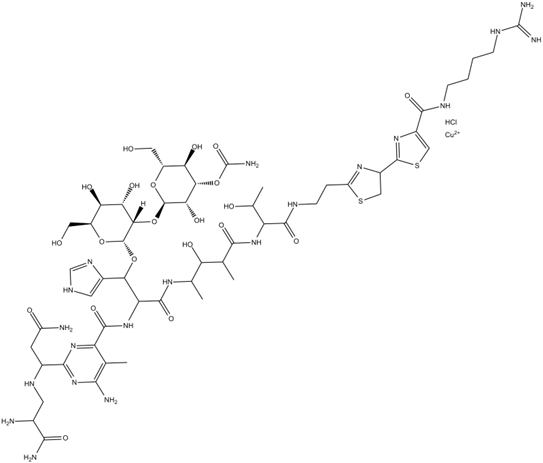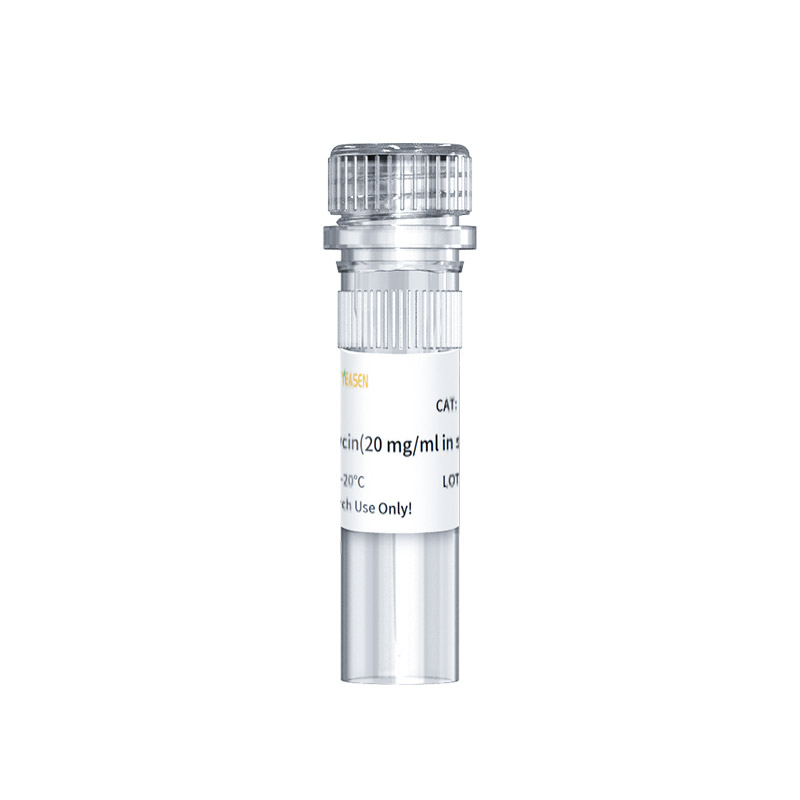Phleomycin (20 mg/mL in solution)
Product Description
Putrescine is one of the selective antibiotics in molecular genetics research and can be used to screen transfected cells carrying the Sh ble gene. Sh ble gene is derived from Streptoalloteichus hindustanus, which encodes 14 kDa protein that binds strongly to phleomycin and inhibits its activity of cutting DNA strands. Phleomycin is a complex of structural analogs that differ only in the terminal amine group. In addition, the solution is blue because it is a complex chelated by copper ions.
Phleomycin (20 mg/mL in solution) is provided as a sterile solution of 20 mg/mL, which can be used directly for cell culture. In the concentration range of 0.1-50 μg/mL, phleomycin can inhibit the growth of most aerobic cells.
Product Properties
|
Concentration |
20 mg/mL in solution |
|
CAS No. |
11006-33-0 |
|
Molecular formula |
C55H85O21N20S2Cu•HCl |
|
Molecular weight |
1525 g/mol |
|
Appearance |
Blue liquid |
|
Purity |
≥95% |
|
Endotoxin level |
< 1.0 EU/mg |
|
Structure |
 |
Shipping and Storage
The product is shipped with an ice pack and can be stored at 4℃ or -20℃. Valid for 12 months at 4℃ and 18 months at -20℃. Avoid repeated freezing and thawing.
Instructions
[Note]:
1) The sensitivity of cells to phleomycin is affected by pH value. For example, the higher the pH value, the higher the sensitivity. In addition, for a high osmotic pressure medium such as medium for protoplast regeneration, the activity of phleomycin will be significantly reduced by 2-3 times. It is therefore also possible to reduce the amount of phleomycin used by using a low-salt medium.
2) Before use, the phleomycin stored at low temperature should be brought back to room temperature, and then fully mixed at low speed.
1. E. coli
Plasmids carrying bleomycin resistance genes such as Sh ble, Tn5, once transformed into Escherichia coli bacteria such as HB101, DH5a, and MC1061, endow them with phleomycin resistance.
Phleomycin-resistant transformants can be grown on low-salt LB agar medium supplemented with 5 μg/mL Phleomycin (Yeast extract 5 g/L, Tryptone 10 g/L, NaCl 5 g/L, Agar 15 g/L, pH 7.5) for screening. Plates supplemented with phleomycin are stable for 1 month at 4°C.
2. Yeast
Phleomycin-resistant transformants of S. cerevisiae can be selected in a YEPD medium supplemented with 10 μg/mL of Phleomycin.
Procedure: Yeast cell transformation is carried out according to the conventional method. Once the DNA has entered the cells, the cells are diluted with YEPD medium and cultured on a shaker for 6 h or overnight to express the resistance traits. The cells were then incubated on ice for 1 h and plated on YEPD (pH 7.0) solid medium supplemented with 10 μg/mL Phleomycin.
3. fungus
Depending on the sensitivity of transformants to Phleomycin, the selection is performed in a regeneration medium supplemented with 10-50 μg/mL phleomycin. Sensitivity to antibiotics can be increased by incubating cells overnight at 4°C and then at the growth temperature.
4. Plant cell
Select 5-25 μg/mL Phleomycin for transformant screening depending on plant type
5. Mammalian cell
Phleomycin: 5 to 50 μg/mL. It is recommended to determine the optimal concentration by establishing a kill curve. Compared to G418, it may take longer to kill cells or to shed them from the plate, especially if the cells are at high density.
Depending on the cell line, it usually takes 5-21 days to select phleomycin-resistant stably transfected cells.
Cautions
1. Saprophycin is sensitive to concentrated acids but can be exposed to dilute acids for a short time. Warm the product to room temperature and mix gently before use.
2. Saprophycin is poisonous, avoid direct contact with skin, and do not swallow. In acidic or alkaline pH or sodium hypophosphate, it will immediately lose effect.
3. For your safety and health, please wear lab coats and disposable gloves for operation.
4. For research use only!
[1] Hu Z, Huang Y, Zhao J, Hu J, Hu S, Liu X. Expression and characterization of a recombinant broadly-reactive monoclonal antibody against group 1 and 2 influenza viruses. Protein Expr Purif. 2022;192:106046. doi:10.1016/j.pep.2022.106046(IF:1.650)
Catalog No.:*
Name*
phone Number:*
Lot:*
Email*
Country:*
Company/Institute:*

